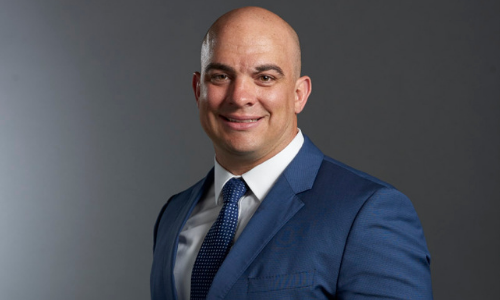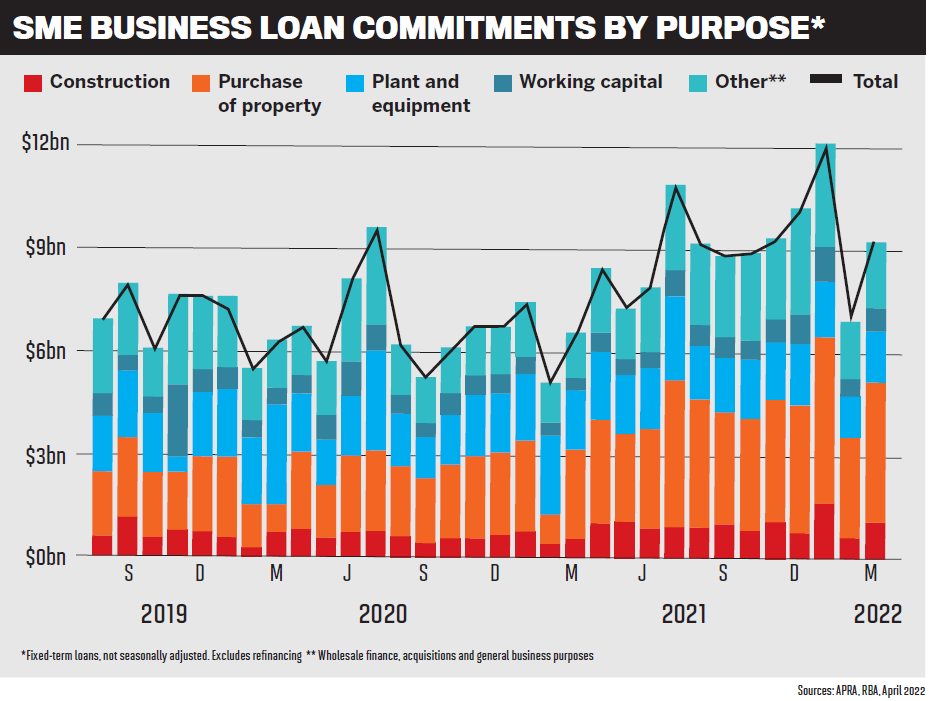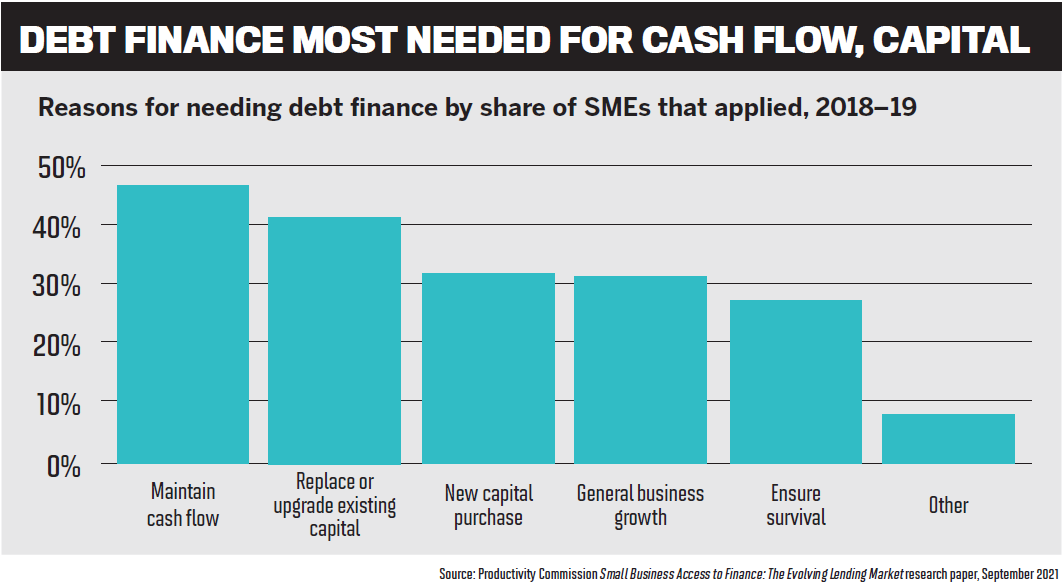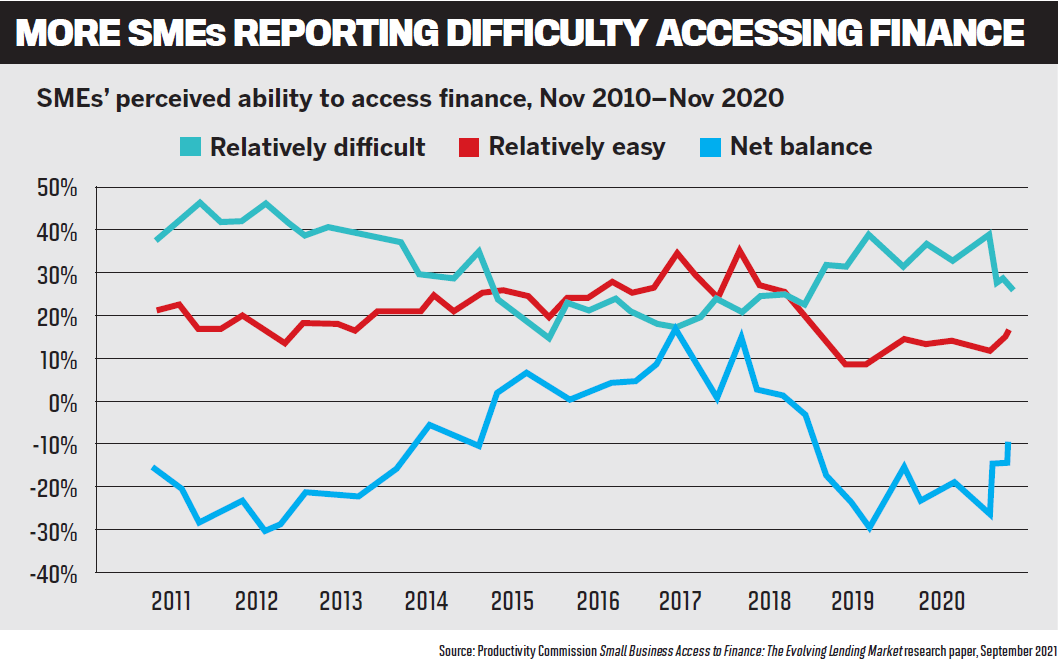Small business seek out lenders, brokers

Small businesses are the lifeblood of Australia’s economy, and with the pandemic now behind them, many are seeking funding to support their growth.
The Australian Small Business and Family Enterprise Ombudsman estimates the nation’s 2.3 million small businesses (with less than 20 employees) represent about 98% of all businesses in Australia. That’s a massive customer base and one that is eager for new funding options.
ScotPac’s September 2021 SME Growth Index shows that two in every three SMEs (66.1%) sourced new funding options during the past year. Of those surveyed, 38% applied for asset and equipment finance, 16.3% sourced new invoice finance, 15.9% sought a new secured bank loan, and 8.8% borrowed from an online fintech.
The reasons for the new funds varied. The majority of businesses (57.5%) allocated the finance to capital expenditure to purchase plant and equipment, while 40.6% used it to improve cash flow. A third (34.3%) paid down debt, 29.3% used the funds to secure large projects or clients, 20.2% wanted to expand capacity, 16.6% refinanced existing loans, 15.1% wanted to hire staff or upskill existing staff, and 7.1% used the funds to enter new markets or create new products.
MPA talks to SME lending specialists from NAB, OnDeck, Grow Finance, Thinktank and Prospa about what’s happening in the sector.
Loan products for SMEs
John Shillington, head of NAB Commercial Broker – NAB Small Business and Regional and Agribusiness, says NAB has a very long and proud history of supporting SME customers.

“It’s long been recognised as Australia’s largest business bank for SME customers, supporting more SME customers than any of our peers,” he says.
“We’ve got more bankers and more locations across Australia, and we do have a broad range of products that support SME customer needs. They can be tailored whether it be through transactional payments for lending needs, through to the specific customer segments at NAB.”
Shillington says NAB can help a range of customers, “whether it’s someone who’s operating a cafe in Sydney or operating a sheep farm in Wagga or someone constructing a property in Brisbane”.
“We do have a very broad range of products and services, and they’re designed to be tailored to the business’s needs,” he says.
OnDeck Australia CEO Cameron Poolman says that since its launch in 2015, the company’s goal has been to revolutionise small business lending.

“In 2016, we launched our free Know Your Score online tool for small businesses to check their credit score. By 2022, over 20,000 small businesses have checked their score,” says Poolman.
Last year, OnDeck launched its innovative KOALA ScoreTM – a sophisticated credit algorithm that helps more small businesses secure the funding needed to expand and grow.
Poolman says the KOALA ScoreTM is a game changer in the Australian small business lending space. It’s significantly more predictive, because it uses a greater range of data sources, including big data, predictive analytics and statistical techniques, combined with data from multiple credit reporting agencies.
“The KOALA ScoreTM supports a more tailored risk assessment for small business lending. This enables us to offer unsecured loans and, in many cases, larger loan sizes to more Australian small businesses,” says Poolman.
“We also launched Lightning Loans, enabling us to give brokers and their small business clients decisions on loans up to $150,000 in as fast as 30 minutes, and funding in as fast as two hours.”
Earlier this year, OnDeck Australia was the subject of a management buyout. Poolman says putting the ownership and decision-making of the company in Australian hands is great news for small business customers and brokers.
He says as a dedicated small business lender OnDeck knows what small businesses want and has the technology ecosystem to deliver access to fast, efficient funding.
“We harness the latest technology to deliver a streamlined application and approval service. It’s a very different approach from traditional lenders which take a backward-looking approach, often asking for previous years’ tax returns to make a lending decision.”
Small business lender Prospa’s purpose is to keep SMEs moving by providing access to working capital, says national sales manager Roberto Sanz. He says this is achieved through two key products that have serviced almost 40,000 small businesses across Australia and New Zealand.

“Our flagship small business loan product provides funding of up to $500,000 that can be accessed in as little as 24 hours,” says Sanz. “We provide flexible repayment options over a fixed term of three to 36 months to work with the business cash flow.”
Prospa’s line-of-credit product offers ongoing access to capital of up to $150,000, so business owners have the flexibility to dip into the funds when needed. The loans have a renewable 24-month term, with interest only paid when the funds are used by the business.
Thinktank general manager partnerships and distribution Peter Vala says the non-bank lender was established in 2006 to offer brokers and their clients a range of commercial loan products that were vastly superior to those available from the banks.

He says Thinktank also offered a broker-centric approach to supporting the application and approval process, and full, flexible commission options that weren’t previously available in the industry.
“The essence of our unique approach was to utilise similar lending concepts as found in residential lending.”
This revolutionised the commercial landscape for brokers and their SME clients by providing set-and-forget facilities with transparent pricing, no annual reviews, no regular compliance measures and no revaluation requirements, Vala says.
As demand grew, Thinktank extended its offering to include line-of-credit facilities, SMSF lending for residential and commercial properties, and residential loans for borrowers such as self-employed, SME and PAYG customers.
At Grow Finance, co-CEOs Gregory Woszczalski and David Verschoor say the non-bank lender’s vision is to support companies to thrive in today’s increasingly complex and competitive operating environment.

“This is achieved by being a centralised funding provider for all asset finance and working capital requirements, including business loans plus asset, trade, invoice, floorplan and insurance premium finance,” Woszczalski says.
Verschoor says Grow also consistently develops new commercial finance products that meet current and emerging demands for flexible funding solutions.
“Grow invests heavily in R&D and has an onshore team with excellent product knowledge fused with the ability to ‘read’ the market, anticipate opportunities, and respond with disruptive products, including product extensions, enhancements and fusions that redefine product classes,” Verschoor says.

Strong teams to support brokers
Having the right staff in place to help brokers and their SME clients with their financial needs is important. Sanz says Prospa’s award-winning team is committed to providing exceptional service to its SME customers and broker partners.
With business lending specialists across Australia and New Zealand, the team can help brokers find the right funding products for their SME clients. Brokers choose how involved they want to be in the process – they can guide clients through the entire application process or refer them to Prospa.
“Our customer service is what sets us apart from the crowd. With a net promoter score of above 80, we have tens of thousands of small businesses and broker partners who rank us as the leading non-bank lender,” Sanz says.
Grow Finance employs more than 60 staff and has offices in Sydney, Melbourne and Brisbane, and a BDM presence in all states. Woszczalski says each BDM has a designated account manager to enhance efficiencies.
“High-touch BDM support is backed by Grow’s highly sophisticated technology, which is intuitive, automated and expedites the loan application process,” he says.
At Thinktank, every broker has their own dedicated relationship manager to ensure easy access to credit and decision-makers, says Vala. They help with workshopping scenarios, assessment of credit applications, restructuring of existing facilities, and structuring of financial solutions to meet each borrower’s individual circumstances.
For brokers working in small business lending, Poolman says OnDeck provides the full support of its dedicated business developers and loan writers, each of whom has been selected and trained to work with the broker channel. The training includes time working as a loans specialist to better understand how OnDeck’s products, processes and credit decisioning meet the needs of small businesses.
“Our experienced team can take their client’s scenario and do the heavy lifting for them – and brokers can be reassured they only deal with one person at OnDeck,” says Poolman.
At NAB, Shillington says, “we have the largest range of business bankers that are dedicated to the broker channel across all locations in Australia, so more brokers can get more support on the ground in their local communities”.
He says NAB has large numbers of bankers in all capital cities but also in regional areas such as Wagga Wagga, Orange, Dubbo and Rockhampton.
“We’re seeing more and more commercial brokers helping businesses in those regional locations as well. We’ve got the people on the ground in those locations that can actually help those brokers face-to-face in those local communities – they understand the area and the types of businesses we’re supporting,” Shillington says.
Market trends
Grow Finance says that while the SME lending landscape is constantly evolving, it has identified a number of current trends. These include:
- high demand for asset finance (trucks, trailers, and materials handling)
- an increase in requirements for
- debt refinancing to reduce cash
- flow pressures
- businesses that have struggled or significantly changed operations rapidly selling unwanted or underutilised assets
- which correlates with increased demand for funding to purchase used assets, exacerbated by supply chain issues for new stock
- SMEs placing orders earlier and making larger orders to offset supply chain uncertainty and keep a comfortable buffer of stock on hand locally
- a sharp rise in demand for fit-outs to accommodate increased patronage as COVID restrictions ease
- the widely accepted hybrid work-from- home model, resulting in mass sea and tree changes as well as a spike in home renovations
- a post-lockdown change in business confidence, which is resulting in active investment in business
Verschoor says these trends correlate with a spike in demand for asset finance, invoice finance and trade finance facilities.
“Brokers can make the most of these opportunities by truly understanding their SME clients’ business, then of course reaching out to Grow to discuss how we can help,” Verschoor says.
Shillington says there are still two speeds in the economy and two types of customers.
“We’ve still got customers that are requiring more support from NAB to help them through what’s been an extremely difficult two years,” he says. “We’ve also got customers that are doing very well now. They’re seeing substantial growth as the economy rebounds strongly, and they need to be supported as well.”
Shillington says there are still some real challenges in the Melbourne CBD, in getting people back to the office and back to work, and NAB is supporting those customers through the government’s COVID recovery loan.
Regional Australia is seeing significant growth, particularly in farming and mining.
“Agribusiness customers are seeing the best conditions in a generation. We’re seeing back-to-back years where we’ve had significant rainfall. They’re producing great crops and great livestock, and we’re seeing commodity prices for that product at the highest levels for a long time,” Shillington says.
He says brokers often ask where NAB sees the opportunities for growth and where they should be focusing. This information is provided to brokers through trading updates and other insights.
Shillington says strong segments in business lending include commercial real estate, professional service providers such as accountants, lawyers and financial planners, and health.
“These are the sectors we highlight to brokers where we’re seeing the growth, and with NAB being the largest business bank, it’s a good barometer of the SME segment.”
NAB can advise brokers on what types of customers to target and has the bankers, BDMs, tools and resources to help brokers grow their businesses.
Poolman says there was an impressive uptick in demand for OnDeck’s unsecured small business lending products in the fourth quarter of 2021.
“In 2021, we saw a 380% jump in loan originations for our broker channel compared to 2020, and we believe additional economic tailwinds will contribute to further growth in 2022.”
OnDeck is highly optimistic that Australia’s small business community will flourish as the economy regains momentum, Poolman says.
“Businesses will require credit to reach their full potential, and this is where brokers can assist, supported by OnDeck’s rapid loan approval process.”
The top five sectors securing finance through OnDeck are construction, accommodation and food services, retail trade, professional services and manufacturing, says Poolman, and this hasn’t changed in the last two years.
Coming out of COVID, Prospa is seeing ongoing demand for capital as SME owners keep pace with a lift in economic activity and look to beat imminent interest rate rises.
Sanz says studies by RFi Group show that almost 40% of small businesses require access to an average of $47,000 in finance.
“It seems many businesses require funds to cover assets, purchase additional inventory, or fund further digital transformations after lockdown. We’re also seeing business owners looking for fixed rates for short-term loans before interest rates start to climb,” Sanz says.
“Access to capital is considered vital, with 87% of small business respondents reporting that they would miss opportunities without it.”
Brokers can play an integral role in helping SMEs access funds through business lending specialists such as Prospa, says Sanz.
Meeting cash flow needs
Vala says the pandemic has highlighted the importance of SMEs having solid cash flow to help deal with unforeseen events.
“With such dramatic change over the past two years, now is the ideal time for brokers to conduct a financial health check with their clients,” he says.
Vala urges brokers to focus on under-standing the borrower’s current financial position, key concerns, and personal and business goals for the next three years and beyond.
He says Thinktank’s 30-year commercial loan terms, along with its flexible set-and-forget approach, significantly reduce monthly loan repayments to free up cash flow.
“A Thinktank loan enables an SME to take advantage of low monthly repayments while still having the ability to make additional capital reductions or accelerated loan repayments,” says Vala. “This offers maximum flexibility to reduce debt when time and cash flow allows, as well as the ability to redraw it whenever needed.”
Consolidation of debt, including one-off ATO liabilities, is also available to boost cash flow, he says. Fixed interest rates and interest-only loans are also options, but it’s important to keep in mind that after the interest-only period, the borrower will have to either repay the debt in full, roll over the facility for another term, or convert it to principal and interest, which may be for a shorter term than preferred.
“With Thinktank, borrowers can benefit from up to 25 years P&I after a five-year interest-only period, which keeps the monthly repayments down to an absolute minimum,” Vala says.
Verschoor and Woszczalski say that as a “one-stop shop” for SMEs’ cash flow needs, Grow is increasingly recognised as the “non-bank of choice” for businesses. Woszczalski adds that while labour shortages, supply chain problems and rising costs are affecting SMEs, Grow can support businesses by providing greater access to aligned finance facilities that release cash flow pressure and support growth via a comprehensive portfolio of asset finance and working capital solutions.
“Asset finance, invoice finance and trade finance facilities help smooth working capital challenges,” says Woszczalski.
Sanz says managing cash flow is one of SMEs’ top challenges, and it’s common that gaps may need to be filled to cover temporary shortfalls or investments to support growth.
He says business owners who turn to lenders that address their personal finances can face strict lending criteria and an extensive appli-cation process.
“Prospa understands small businesses. That’s why our simple application process can take 10 minutes, approvals are made fast and funding is possible in 24 hours.”
Sanz says some business owners are using funds to increase stock orders and manage supply chain problems or cover rising costs before passing those costs on to their customers.
Shillington says there are a few ways NAB supports cash flow needs.
The bank has COVID-19 loans available, which brokers can use to assist their customers.
“They’re great opportunities for customers that are still experiencing some stress after the last two years to provide some capital into those businesses to keep them trading, and try to get them out of that cycle and back into growth,” says Shillington.
NAB has also recently relaunched its QuickBiz product – an unsecured business loan for new and existing customers. It requires no director guarantees, no charges over the company, and no bricks-and-mortar security.
“This is a product where brokers and customers can apply for finance and get cash to that customer in 15 minutes. It’s a quick and simple way NAB can help with cash flow needs,” says Shillington.
“They can get a digital decision on the spot. If it’s approved, there’s no paperwork sent out to the customer. There’s no other bank in Australia and we believe globally that’s taking a customer from application through to money in the account in such a short space of time.”
NAB is also one of the largest providers of trade working capital funding for customers who are importing product from overseas, bringing it to Australia and selling it here.
“We can help the customer finance the original purchase of those goods overseas, do the foreign exchange, finance it while it’s here in Australia, and then once it’s sold the money is paid back.”
Solutions to business hurdles
OnDeck anticipates that many small businesses will want to invest in new plant and equipment to take advantage of temporary full expensing ahead of 30 June 2022, and this provides valuable opportunities for brokers.
Poolman says there has been a big increase in applications for finance from transport or transport-related businesses, as logistics has played an important role during the pandemic.
Vala says lockdowns and restrictions have made it hard for SMEs to report accurately on their performance, resulting in lenders declining finance or making the submission process lengthy and tortuous. Thinktank’s commercial and residential mid-doc products help remove this barrier by only requiring a self-certified income declaration and one other form of documentation (accountant’s letter, last two BAS, or six months’ bank statements) to support current income.
Shillington says interest rates are the hottest topic for brokers and customers at present. “We’re clearly going into an interest rate environment that Australia has not seen for a long time. A lot of customers and brokers haven’t seen for a long time an environment where rates and funding costs are both on the increase.”
NAB wants to educate customers and brokers on what the next few years will look like “as we see both funding costs and interest rates from the Reserve Bank increasing”.
Helping brokers seize opportunities
Grow Finance’s co-CEOs encourage brokers to diversify to offer more holistic client outcomes while increasing their business revenue and accelerating growth.
Verschoor says the non-bank lender helps brokers accelerate their diversification into commercial finance and allows them to often “cross-sell without the upskill”.
“The platform auto-prompts which cross-selling opportunities are aligned with the business client’s profile,” he says.
Grow also encourages brokers to tell their local BDMs how business funding can help their clients, who in turn will recommend the aligned finance, whether it’s a straightforward product or a more multi-dimensional solution.
Sanz encourages brokers wanting to diversify to partner with Prospa and “open the door to an array of opportunities”.
“There are more than two million small businesses across Australia, combined with the increase in demand for capital. It’s time to act,” he says.
“Brokers should start by reaching out to clients that may be self-employed or own a business to learn about their future business plans. Through the discussion you might find that these clients may require short-term business loans, providing brokers an opportunity to diversify revenue.”
Sanz says Prospa understands that access to funds is difficult, with studies last year showing that SMEs were declined a total of $23.9bn by traditional lenders across Australia.
That’s why Prospa has invested in technology to ensure that applications are easy and decisions are fast, so funds can be accessed in as little as 24 hours, he says.
Shillington says NAB now has more BDMs in more locations across Australia.
“If it’s a business wanting to diversify into commercial, the first step would be to get in touch with their BDM,” he says.
NAB also has a range of tools and resources available on its website at nabbroker.com.au, which can assist brokers who want to improve their customer lending capabilities. These include a customer conversation tool that guides a broker through a needs-based conversation with a business customer.
“We’ve also got calculators and credit assessment tools which allow the broker to take the information they’ve gathered and input it, and it tells them whether it fits NAB’s risk appetite,” says Shillington.
For brokers wanting to diversify, Poolman says it’s important to realise that a quarter of brokers’ home loan clients are likely to be business owners, so there’s already a trust-based relationship.
“Brokers also play a valuable role in letting small businesses know that their funding options extend beyond mainstream banks,” he says.
OnDeck research shows that one in four small businesses are rejected for finance by a mainstream bank, and as many as 25% of those approved for loans report delays in the lending process that have negatively affected their businesses.
Poolman says that as small business experts, the team at OnDeck are committed to eliminating the ‘slow no’ from the business lending environment.
Vala says SMEs are often called the engine room of the economy and represent an enormous opportunity for brokers equipped with the right skills and insight.
He says Thinktank runs regular face-to-face and online education sessions on commercial, residential and SMSF lending, and its highly experienced team can help brokers grow their businesses.





